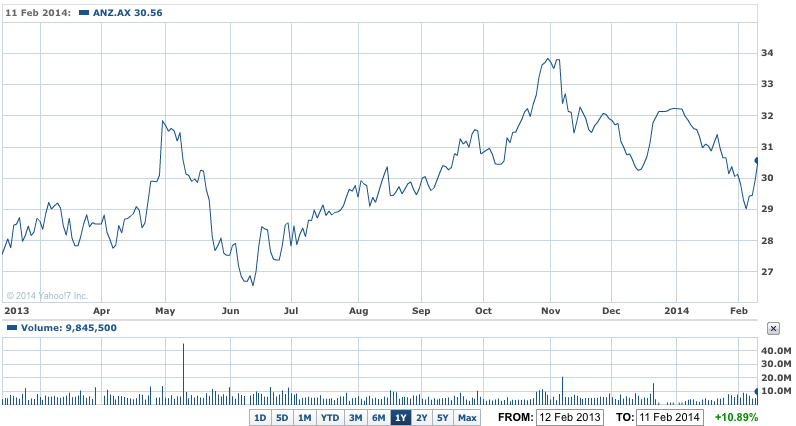A sharp fall (yet again for a big bank) in bad debts at the ANZ in the three months to December prompted a sharp reappraisal of the outlook for the banks yesterday, a day before the CBA reported its record interim result.
The ANZ said cash profits rose to $1.73 billion in the first quarter, a rise of around 13%, which was much stronger than many market forecasts.
The news saw the share prices of the big four banks jump. The ANZ was up by 2.2% to $30.56.
The Commonwealth was up 1.4% at $75.92, the NAB rose 1.4% to $33.89 and Westpac was up 1.5% at $33.23.
The ANZ result, plus the NAB’s latest business conditions report and data on home pries and housing finance, helped push the Aussie dollar back over 90 USc in Asian trading yesterday.
The ANZ update helped trigger a solid rebound on the ASX, which had been searching for a lead in early trading after a couple of weak profit reports. The market added 37 points on the ASX 200, or just under 0.7%.
ANZ 1Y – ANZ lifts bank stocks, broader market

In its update yesterday, the ANZ said that business conditions were in line with previous guidance it had provided at the AGM in late 2013. It reaffirmed expectations for revenue growth of 4% to 5% for the year to September 30.
In fact if anything, business conditions are a bit better than many analysts had been expecting. The National Australia Bank yesterday said that for a second month running, business conditions were near three year highs in January.
Despite the improvement and solid expectations for revenue, the big driver was the sharp fall in the provision for bad and doubtful debts – down to $191 million from $311 million in the first quarter of 2012-13 and $322 million in the September quarter of last year.
Cash earnings were up $200 million from the $1.53 million reported a year ago, meaning that the fall in bad debt provisions accounted for more than half that improvement – some $120 million.
After falling bad debts last year helped drive profit growth across the Australian banks, analysts had been wondering if the improvement could continue into 2014, with unemployment rising and some sectors of the economy not travelling well.
But it seems that, according to the ANZ, there’s every chance it can continue with the bank forecasting a 10% fall in bad debt provisions this year from 2012-13.
But it will have an early problem debt to deal with this quarter – the struggling contractor and engineer, Forge Group (FGE), which collapsed yesterday.
The ANZ had been financially supporting it from last November, until Monday night when it decided to terminate the support after Forge indicated it couldn’t find a new equity partner.
Forge had it shares suspended yesterday until Thursday to give it time to work out a strategy.
Forge then appointed Ferrier Hodgson as administrator, but the ANZ will take control by appointing KordaMentha.
The size of the potential losses in this deal haven’t been released by the ANZ, but they will be larger than initial estimates.
Bank CEO Mike Smith said in yesterday’s statement that the ANZ’s strategy of pursuing expansion in Asia was delivering ”consistent improvement in business growth and financial performance”.
"The bottom line is that we have made a good start to 2014.
”There remain a number of challenging issues in the global economic environment however these are now largely more predictable. Our performance in the first quarter means we are on track to deliver a solid 2014," Mr Smith said in a statement.
ANZ said group margins were "slightly lower" because of the low current interest rate environment. That is continuing to squeeze lending spreads.
The ANZ said its international and institutional business had performed well, with global markets revenue growing by 5.7% to $600 million.
"In the international and institutional banking division, global Markets, trade and cash management have performed strongly particularly in Asia where a number of our country operations delivered double-digit growth in revenue including Singapore, China and Hong Kong,’‘ Mr Smith said.
Mr Smith noted the bank’s expansion in market share in domestic mortgages – it has grown more quickly than overall growth in credit for the past 16 quarters.
The Australian home lending market is the real growth engine for new businesses for banks at the moment.
ABS data yesterday shows that home loans for housing finance jumped 27% in calendar 2013, driven by a 41% surge in lending to investors.
Most of the money came from the banks, according to the ABS data.













